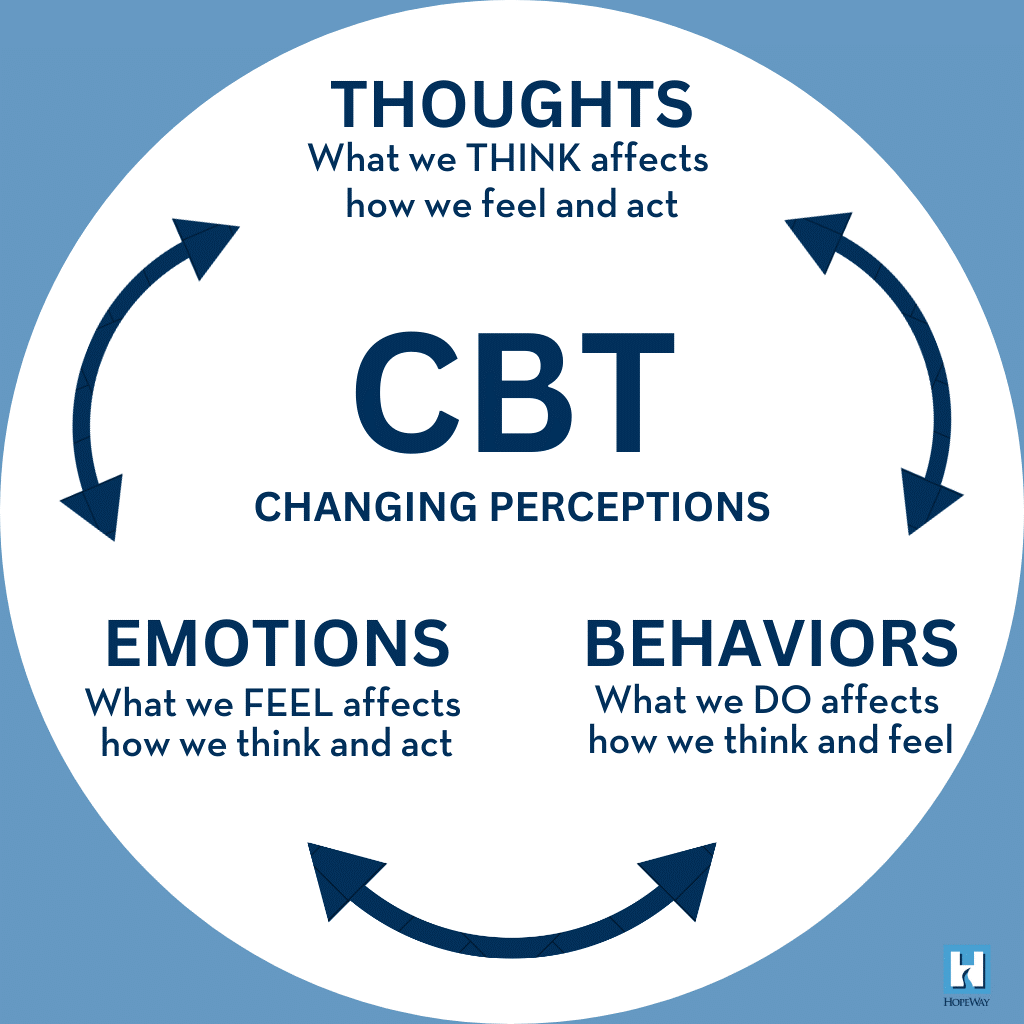- Eye Movement Desensitization & Reprocessing Therapy (EMDR)
- Prolonged Exposure (PE)
- Cognitive Processing Therapy (CPT)
- Dialectical Behavioral Therapy (DBT)
- Cognitive Behavioral Therapy (CBT)
- Enhanced Cognitive Behavioral Therapy (CBT-E)
- Family Based Treatment (FBT)
- Acceptance and Commitment Therapy (ACT)
- Radically Open Dialectical Behavior Therapy (RO DBT)
Cognitive Behavioral Therapy (CBT)
What is CBT?
Cognitive Behavioral Therapy (CBT) is a type of talk therapy that focuses on the relationship between your thoughts, feelings, and behaviors. Many times, problems such as anxiety and depression involve unhealthy thoughts that CBT can help alleviate and/or reduce the emotional impact these negative thoughts have on the person.

When starting CBT, it helps to take note of your thoughts, feelings, and behaviors that are related to an identified problem the client wants to work on. CBT treatment includes assessing negative core beliefs, cognitive distortions and then learning ways to challenge those negative thoughts/ beliefs.
Common Negative Core Beliefs
“Self-talk” stems from deep-rooted beliefs we have about ourselves which are typically formed in childhood. Some of these common negative core beliefs are:
1. “I’m a failure.”
2. “I’m not good enough.”
3. “Everyone will leave me.”
4. “I’ll never get better.”
Common Cognitive Distortions
Because we can see the world through a negative filter, it tends to have a distorted view. Some cognitive distortions are:
1. Black and White Thinking: seeing the world in two camps, and no in-between
2. Catastrophic Thinking: a way of thinking that assumes the worst or a situation will have a far worse outcome than what is realistic
3. Mind Reading: believing you know what others are thinking or feeling
4. Fortune Telling: when we try to predict the future and believe our predictions are true
Once you can identify these inaccurate thought patterns, you can learn to challenge them.
Common Thought-Challenging Techniques
1. Reframing: When we use this technique, we restructure our thought to help us challenge its initial meaning and see the thought differently.
2. Putting Thoughts on Trial: When we use this technique, we evaluate the evidence for and the evidence against the thought. We pretend that we are bringing the thought to a judge, and we need to show the judge evidence based on facts, and not on feelings. Finding evidence against a thought can be difficult on your own, so don’t be afraid to ask for help. When you feel like you have evaluated all of the evidence, see what the verdict is.
3. Decatastrophizing: When we use this technique, we explore the worst case, best case, and most likely scenario. It helps break down an overwhelming situation into more manageable steps.
4. Socratic Questioning: When we use this technique, we answer a series of open-ended questions to explore the thought and see if it’s based on fact or feeling.
The goal of these tools is to help individuals restructure their thoughts to support their mental health.
.jpg)
CBT can be done in an individual and group format. In group therapy, we tie these skills together and help clients identify, challenge, and reframe negative thinking patterns that can lead to distressing emotions and maladaptive coping mechanisms. In individual therapy, we explore the root of core beliefs and challenge them further.
In short, CBT is a "problem-focused" and "action-oriented" treatment model that aligns with HopeWay's mission of equipping clients with the tools they need to lead successful and fulfilling lives.
If you are in crisis, please call the Suicide Prevention Lifeline
